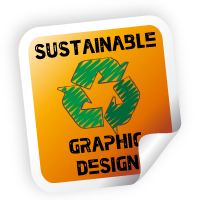The sustainable designers quick guide to recycled paper. In the previous quick guide to paper there is information on virgin fibre paper, additives and coatings. Here we'll focus on recycled paper.
According to the United States EPA production of recycled paper causes 35% less water pollution and 74% less air pollution than making virgin paper.
It also stops trees being cut down. However due to the de-inking process it can result in waste sludge of around 20% by weight of the paper being recycled (check out the quick guide to ink for more info on de-inking).
Paper content
Recycled paper is made from either pre-consumer waste or post-consumer waste and may also include a percentage of virgin wood fibre.
Pre-consumer waste content is waste fibre from paper mills that never reached the consumer (cut offs, rejects, etc.)
Post-consumer waste content is the fibre that is made from recycled office and home waste.
*Post-consumer waste content is considered better than pre-consumer because it is more likely to end up in landfills if it is not reused.
- Grades of waste paper
- Grades of pulp and paper
Brightness
Sometimes post-consumer waste recycled paper has slightly more small specks in the paper than virgin sheets. This is due to the recycling and de-inking process and the type of ink that was on the waste paper.
Recycled papers may be a point or two lower in brightness than their virgin paper counterparts. However, recycled papers generally have higher opacity (which means they are harder to see through), often considered an asset, especially for double-sided printing.
Designers can save on paper by using a thinner, less expensive sheet if it has more opacity. Using a thinner sheet can also save on mailing costs.
If your print job has 100% ink coverage then the slightly less bright recycled paper will not effect the finished product.
One of the factors that effects brightness is how paper is bleached. Here I'll go into the process in more detail and the various end-options that you can choose from when selecting paper.
Chlorine bleaching and Chlorine-free Paper
Chlorine bleaching is used to give paper its bright white colour. It can also have a negative effect on the environment. When chlorine is used to bleach paper the process can also result in the formation of harmful chemicals such as dioxins and furans, which are known to cause cancer in humans.
Other options for bleaching paper are available to the paper industry and these include oxygen bleaching. The safest paper bleaching processes are totally chlorine-free (TCF) or processed chlorine-free (PCF).
 Here are brief explanations and some common logos (depending on where you live):
Here are brief explanations and some common logos (depending on where you live):Totally chlorine-free (TCF): Virgin paper produced without chlorine or chlorine derivatives (the bleaching process uses oxygen-based compounds).
Processed chlorine-free (PCF): Contains recycled content produced without elemental chlorine or chlorine derivatives, although one or more fibre components may have originally been bleached with chlorine or chlorine derivatives. Any virgin pulp is TCF.
Elemental chlorine-free (Traditional ECF): Replaces elemental chlorine with chlorine dioxide in the bleaching process.
Enhanced ECF (ECF with extended or oxygen delignification): Removes more of the lignin from the wood before bleaching, thus reducing energy and chemical use during bleaching (the final stage uses chlorine dioxide).
Enhanced ECF with ozone or hydrogen peroxide: In addition to removing more of the lignin from the wood before bleaching, substitutes ozone or hydrogen peroxide for chlorine or chlorine dioxides as a brightening agent in the initial stages of the bleaching process (the final or near-final stage uses chlorine dioxide).
Which Chlorine Free Paper is best?
So on the basis of environmental criteria the best paper to get is:
- PCF (because product includes recycled content)
- TCF (TCF is used only to refer to 100 percent virgin paper)
- Enhanced ECF with ozone or hydrogen peroxide
- Enhanced ECF (ECF with extended or oxygen delignification)
- Traditional ECF
To find out more about chlorine free products go to:
Natural Resources Defense Council
The Chlorine Free Products Association (CFPA)
Environmentally responsible printing
Sustainable forestry management
In addition to recycled paper there are also certifications that can be applied to paper obtained from sustainable forests. The two main certification programs are:
PEFC Programme for the Endorsement of Forest Certification
FSC Forest Stewardship Council
Depending on which country you live in, there are various logos to signify sustainable forestry management.
Carbon Neutral Production
A product or company that have had their carbon dioxide and greenhouse gas emissions calculated, reduced and offset with credits from fund renewable, emission free energy products can be verified as carbon neutral.
Increasingly companies are becoming carbon neutral by buying credits from carbon offset schemes to become sustainable. Various standards and certification exist for different countries. Here are a few common logos for carbon neutral products.
In addition to these varieties of recycled paper, there is also acid-free paper and the various additives (sizing) and coatings. These are covered in the sustainable designers quick guide to paper.
























